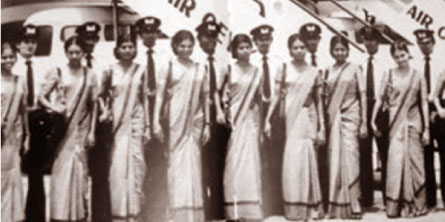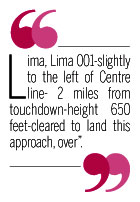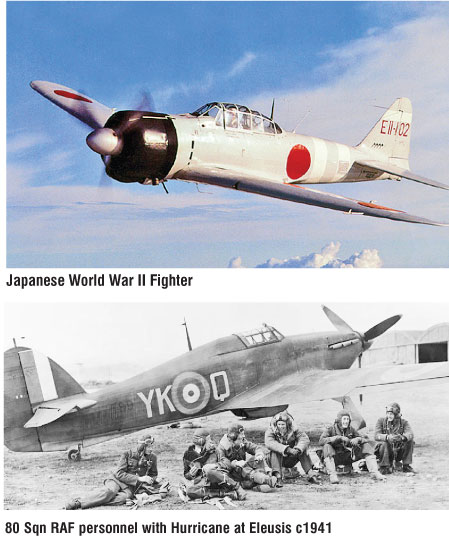
 |
| Air Ceylon flight crew |
When flying in concealed formation, a raiding squadron of Japanese Zero fighters, Aichi dive bombers and Nakajima attack bombers, led by the Japanese aviator Commander Fuchida who headed the massive raid on Pearl Harbour, suddenly made their ferocious descent on Ratmalana and Colombo on the morning of 4 April 1942, with guns blazing, and the RAF radar at Ratmalana switched off on Sundays, for routine maintenance! The islanders were indeed surprised. Although heavily outnumbered, the gallant RAF crews managed to put up a determined counterstrike as 24 hurricanes took wing to engage the enemy.
One enemy plane was shot down and crash landed at the S. Thomas’ College grounds. This fiery aerial display was certainly not the kind of aviation expected in Ceylon!
First Flight
The first airplane or ‘iron bird’ to arrive in the island, actually came as cargo on a ship named Rabenfels, to a man named Colin Brown, sometime during September 1911. He put this flying machine on exhibition first. In December 1911 a German pilot named Oster who arrived in Ceylon was keen to fly, and made his first attempt at the Colombo Race Course in a monoplane, named, an Etrich Taube (Taube being the German word for pigeon). However, he failed at 40 feet and crashed. He tried again on another date and encountered failure.

By this time, Brown obtained the services of two Frenchmen named George Verminck and Marc Poorp to assemble his airplane. An eager crowd had gathered at the resplendent turf to witness this magnificent milestone, in the history of the island. I am sure this anticipation outdid the normal expectations of the horse races that once made it Colombo’s most ‘happening’ venue.
As the propeller was cranked by robust hands the engine spurted to life and its mechanical roar heralded the birth of aviation in Ceylon on 7 December 1912, as the Bleriot monoplane took off and made a full flight with a safe landing. The Bleriot airplane was named after French aviator Louise Bleriot. However, it was 19 years later that a second iron bird made a spectacular landing at the Royal Colombo Golf Club on 7 May 1931, piloted by the Director- Civil Aviation of India, Neville Vincent. The islanders were once again mesmerized by the De Havilland Puss Moth aircraft.
It is opined that around 1931 the Colombo Flying Club was established by John Kotelawala. In 1934, the State acquired 242 acres of coconut plantation at Ratmalana and built a runway, 600 yards long.
During this year, the first plane landed at the rudimentary airfield piloted by Flight Lt. Harold Lindale Biscoe, an instructor of the Madras Flying Club. Registration of airplanes and promulgation of Air Navigation regulations also took form in 1937. The Ratmalana airport was declared open in 1938 by Governor, Sir Andrew Caldecott. It is noteworthy to remember that by 1938 there was a solitary WACO biplane, taking airmail from Ceylon to India!
Adolf Hitler’s diabolic quest for supremacy had taken the Second World War to frenzied levels of fighting in the airborne theatre. Aerial battles were a decisive factor for both, the Nazis and Allies. The British Royal Air Force had set up a workshop at Koggala, and also an airfield at China Bay. Realizing the need to provide air support to the naval forces already entrenched at Trincomalee, the British deployed a Squadron of 30 -Fighters (pronounced three zero) in 1942. The aircraft operated out of Ratmalana. At times even elephants were used to tow aircraft onto the runways at Koggala! The efficient air crews at Ratmalana were able to handle 50 take offs daily.
Love laden flights
By 1943, the large Catalina twin engine planes were flying for Qantas Empire Airways. The magnificent planes soon began flights to Colombo. Flying in that era was certainly a luxury and still remains a rather costly affair for many Sri Lankans. The 28 hour flight had a very unique feature where passengers were able to delightfully witness two dawns! Hence, the pioneers of aviation advertising dubbed this splendid air journey as the ‘flight of the double sunrise’.
The air stewardesses of that era were also trained as nurses because the aircraft cabins were not pressurized at that time and passengers were prone to display symptoms of air sickness. The Department of Civil Aviation was established in 1947, and was located at Trans Works House, Fort.

Sir John Kotelawala was a visionary leader. He initiated the enterprise of Ceylon Airways, sometime in 1947. For this purpose, he acquired three DC-3 planes which were sold off as war surplus.
They were registered under the Ministry of Communication and Works. The aircraft were named Sita Devi, Viharamaha Devi and Sunethra Devi.
The influence of air travel and the expansion of global commerce were soon realized.
On 10 December 1947 Air Ceylon was established with the inaugural flight taking 16 passengers from Ratmalana to Madras.
The plane was piloted by Capt. Peter Fernando, and Ms. Mavis Wijeratne became the first air hostess. In 1948, Ceylon became a member of the International Civil Aviation Organization (ICAO).
Air Ceylon formed a partnership with BOAC in 1962 and by 1972 had acquired a Douglas DC-8 jet. In 1978, an Air Ceylon Avro parked at Ratmalana was exploded by a bomb, reducing the plane to a heap of twisted metal.
Air Lanka came into operation in 1979 with a fleet of 2 Boeing 707aircraft. Later on, a Lockheed Tristar l1011 was added to the fleet.
In 1998, the airline partnered with Emirates. Shortly afterwards, the airline was rebranded as Sri Lankan Airlines and boasted a new fleet of six Airbus A330. After the agreement with Emirates terminated in 2008, SriLankan Airlines joined the One World alliance in 2012.
Tragic skies
One of the notable air accidents that took place in Sri Lanka is recorded in December 1974 when a Martin Air flight 138 crashed into the Saptha Kanya Mountain at Maskeliya. The aircraft had descended below safe altitude.
It is recorded that 182 passengers, all Indonesian pilgrims perished in the crash along with 9 crew. In 1976, the Primary Surveillance Radar (PSR) was commissioned at BIA, Kaunayake, in readiness for the Non Aligned Nations Summit.
A second air crash took place at Katunayake in November 1978. The plane, Icelandic Airlines Flight 001 was making an ILS approach towards runway 22.
The last contact message from Radar Control to the flight is recorded thus, “Lima, Lima 001-slightly to the left of Centre line- 2 miles from touchdown-height 650 feet-cleared to land this approach, over”.
Shortly afterwards, Approach Control had noticed the plane descending too low and warned the pilot on approach frequency 119.7. The pilot was still tuned to Radar Control frequency 119.1 and didn’t hear the warning. Engulfed in flames on impact, 184 passengers perished. All passengers were Muslim pilgrims.
Flying forward
The present International airport at Katunayake was developed with assistance from Canada in 1963 and work completed in 1968.
In 1986 the world’s first supersonic Concord jet touched down at Katunayake. Since then the airport has been upgraded, and today, boasts 6 aero bridges. In 2012 Sri Lanka proudly celebrated 100 years of civil aviation. A second airport was built at Mattala, Hambantota in 2013. Ever since the first global aviation conference was held in Chicago (1944), we celebrate International Civil Aviation Day on 7 December.
According to IATA Director General, Tony Tyler the aviation industry provides almost 58 million jobs globally. By 2020, airlines hope to cut down on their emission and become carbon- neutral. Some airlines are hoping to introduce electronic bag tags. Aviation faces new challenges in the Asian region; hence, airlines must focus on sustainability, technological innovation and profitability to soar to new realms of success.
